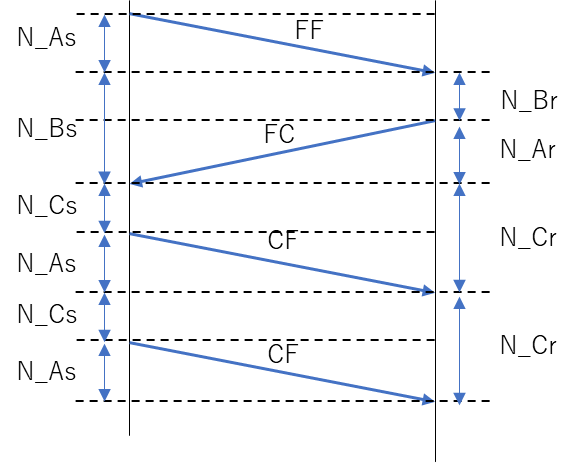Click here for back issues.
https://www.simulationroom999.com/blog/diagnostic-communication-en-back-issue/
Introduction.
Explanation of the network layer of vehicle diagnostic communication.
This time will be an explanation of various timeout-related issues.
Various timeouts
The majority of communication is based on timeout decisions.
In other words, timeouts are quite complicated.
First, a brief explanation of the name of each timeout is given below.
- N_As: Timeout value when a frame transmission is attempted
- N_Bs: Timeout value from completion of FF/CF transmission to FC reception
- N_Cs: Timeout value from the completion of FC reception/CF transmission to the start of the next CF transmission
- N_Ar: Timeout value when FC transmission is attempted
- N_Br: Timeout value from FF reception to the start of FC transmission
- N_Cr: Timeout value from CF reception to the next CF reception
At this stage, you may think that the meaning is unclear.
The major parts are as follows.
- The value ending in “s” is the timeout value for the message sender.
- The “r” ending indicates the timeout value of the message receiver.
You may not feel like you are making progress in understanding this.
diagrams of various timeouts
To facilitate understanding, let me diagram the various timeout parameters.
Timeout parameters when sending a single frame
First, a simple diagram of timeout parameters for SF transmission is shown below.

The only parameter used will be N_As.
Since only one frame is transmitted, as a result, the parameters required for message transmission are limited.
Up to this point, it should be easy.
Timeout parameters when sending multiframes
And here is a diagram of the timeout parameters for multiframe transmission.

Unlike the previous SF, many timeout parameters appear not only on the sending side but also on the receiving side.
So, when designing & implementing ISO-TP, the handling of timeout parameters in these areas is the main concern.
Other timeout parameters
In actual communication, the flow is request and response.
Therefore, there may be a timeout between sending a request message and receiving a response message, but these have not appeared yet.
In this article, I do not explain them, but only show the parameters necessary for decomposition and construction of messages corresponding to ISO 15765-2.
In fact, there are also timeout parameters in ISO 14229-1, which defines a layer higher than this.
However, the timeout is only a timeout after the message has been established, so if there is an error in the ISO-TP (ISO15765-2) stage, it will not even be determined in the first place.
This will be explained in due course.
Conclusion.
- ISO-TP has six timeout parameters.
- N_As, N_Bs, N_Cs, N_Ar, N_Br, and N_Cr.
- Single frame transmission is complete in one frame, so only N_As.
- Multi-frame transmission uses all parameters.
- ISO-TP only determines the timeout at the frame level, and the timeout per message is determined by a higher layer.
Click here for back issues.
![[DoCAN] Vehicle Diagnostic Communication Part 11 [ISO-TP 7]](https://www.simulationroom999.com/blog/wp-content/uploads/2022/11/01_eyecatch-7.png)



コメント